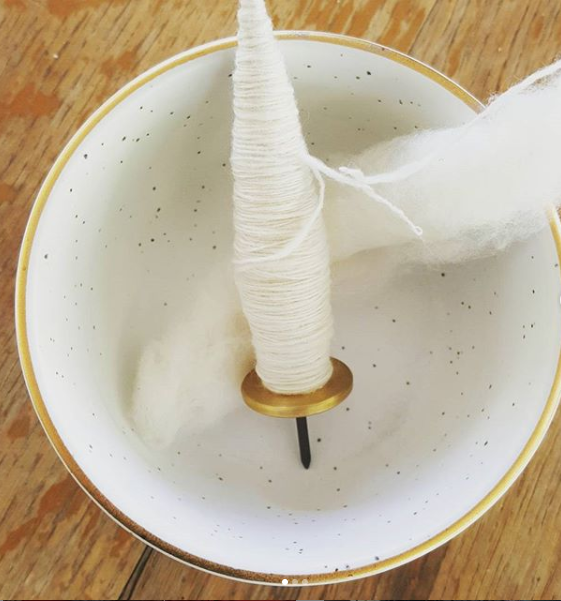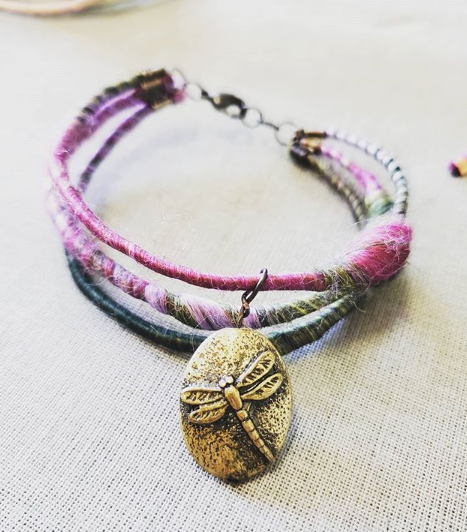Some people do one thing and some want to do it all: create art, make everything from scratch, cook, grow, try their hand at any craft that comes their way. Meet Darla Jean Romero (34) from Whittier, California, in the yarn spinning world also known as Spinstress D. It is hard to define her as anything else than a maker to the core – one craft always leads to another.
“I like to compare myself to the book “If you Give a Mouse a Cookie” , I’m told I like to go down the rabbit-hole, and I guess this is true. My two great loves are food and fiber. I’m a passionate home-chef-wannabe and an obsessed fiber artist! I am a spinner before everything, but I do love knitting, crochet, weaving, dying, carding, and growing.” – says Darla.

“If you give a mouse a cookie, he’s going to ask for a glass of milk. When you give him the milk, he’ll probably ask you for a straw. When he’s finished, he’ll ask you for a napkin.”
I love how growing is one of the fiber arts on your list! Now, I want it to be established that if there is one thing that I am irrationally afraid of and grossed out by at the same time, it is caterpillar. So when I saw that you are raising silk worms, I had way too many emotions at first: they are huge, they are scary, but at the same time, you treat them like pets and seem to think they are cute.
I am also a massive fan of making things from scratch and growing your own mulberry trees, feeding their leaves to caterpillars, harvesting the silk they produce, processing it and then spinning it into yarn and then weave that yarn into fabric – sounds like a DEFINITION of “from scratch”. So… How did you get acquainted with fiber arts and raising silk worms? It is a rather rare areas to get into. What does your family think? Friends?

In general, I guess I started in elementary school. My best friend and I would make braids and bury them in the sand – I have no idea why. I dabbled in crochet and macrame throughout the years but the real obsession started in 2015. I saw this guys spinning yarn on a Saxony-style wheel and mind you, I had a few meads, it totally blew my mind! It was all down hill from here.

I had originally raised silkworms in middle school as a science project with the rest of my class. So, once I got into fiber, it was a very natural and comfortable direction to take.
That’s so funny that you have so many emotions about the silkworms, many others have the same feelings, much to my surprise! But, I think I find that very fitting because they are simple, but amazing creatures with a legacy of their own.
I take comfort in knowing that I am not the only one grossed out by them. Fascinated too, but grossed out and scared firstly. It almost sounds as if many people in California grow silk-worms, so natural! where do you even get them?
When I started working with different fibers and wanted to learn more about silk, YouTube would always take me to videos of Indian women in a sweat shop looking environment, processing silk by hand. It looked like a hard, harsh job with very little pay, to produce this expensive, fancy luxury item. Never even in my wildest dreams I could have imagined, that people in US can do that in their own homes!
I order my eggs online from Virginia. I don’t know anyone else who raises silkworms in California. Its really just about the mulberry trees. I think its as involved as growing vegetables or anything else. Easier than chickens I’ll tell you that much.
Tell me more about silk processing. What steps do you have to take and where do they start?
I keep the eggs in a little container on the counter for a week or so until they start hatching then I begin to feed them chopped mulberry leaves, the young tender leaves are best for little worms. After a week I move them to a plastic storage bin and continue to feed them chopped young leaves for another week, still inside because it’s too chilly outside. Once they become too big and crowded in that bin I start separating into multiple bins and begin feeding the mature leaves. I’ll do this till they begin to “throw silk” showing they are ready to spin. Then I move the “spinners” to bins with paper rolls. I used to use toilet paper rolls but I think those were a little too wide so now I make them. I stack the rolls and watch and feed or “finish” them so that they make cocoons.
Once they’ve formed a solid cocoon I cut the top open and remove the pupa so that it can continue to develop in another bin without damaging the silk when it emerges. More of the moths will survive this way and not risk becoming stuck half way out of the cocoon. This has been my personal and shared experience. I’m pretty much done caring for them at that point. They don’t have mouths as moths so they breed and die naturally.
“All the caterpillar girls are named Molly and the boys are named Barry. After the Mul-berry leaves they eat. Get it?! “
Darla
Then I collect their eggs and put them in the fridge for next year. The cocoons need to be boiled in water with baking soda and dish detergent for hours to break down the sericin (the hardening agent that makes the cocoon solid) and release the silk.
I collect all of it. But I don’t really separate it into into different fibers. It’s definitely not worth the trouble if you’re trying to save money or make all your own. It‘s value is in the knowledge and the bragging rights!
In Southern California I have from about March till October. Pretty much as soon as the trees put on leaves until they drop – I can feed the worms.
You mentioned on your Instagram, that you also want to grow cotton. Tell me more about that. Ironically, even though cotton is what most of our commercially made clothes consist of, it is still a fiber that many people, including me, know little about. Do you actually spin cotton yourself?
That’s true. The info isn’t out there but it is actually a very simple process! I do spin it. There is a video on my Instagram of me doing a little impromptu spinning right off the bush. My daughter and I visited our local arboretum and they just happened to have some cotton bushes, JACKPOT! We fill our bags with the underappreciated stuff and its still sitting in my stash to date.

Its time consuming to process so I’ve only worked on some of it. But that doesn’t stop me from adding to the hoard. It is definitely a process letting your hands learn to spin differently. I think us wool spinners see it as advanced level. But regions that grown cotton learn to spin that as beginners. it’s just a different skill set. You can only spin it long draw and with a lot of twist! I am working on beginning to offer tutorials so stay tuned!G
On Instagram in your bio you say that you spin fine art yarn. How do you define/describe fine art yarn? I have a personal preference to spin singles blended from variety of fibers and am not particularly into art yarn. Other spinners work with plying a lot and make a lot of 100% wool, everyone has a preference! So I am curious how come your preference is art yarn?

I think the reason I say “fine” is half because its all about detailed technique. Letting the fibers qualities shine and maximizing color representation. There’s nothing worse that buying a gorgeous batt loaded with “additions” only to lose them in the spin. I let the fiber tell me how to spin it.. And half because I prefer to spin yarns that are a finer weight, art yarn speaking. Not to say I won’t indulge in a super chunky spin! I don’t know why. Just cause I’m a complicated, difficult person in general, ask my husband! I think I feel like if I can’t do it all I’ve failed or I’m not good enough.
I think I love art yarn because I’m a Virgo. So I can be rigid and practical about colors and organization in real life. Art yarn sets me free from that. Its my safe place to be colorful and without practicality.
Do you have favorite knit/crochet designers or Instagram profile; do you buy patterns or prefer to free-hand items you make?

Of course I do! I follow so many amazing artist but I guess if I had to name some I would say Tiny Owl Knits (https://www.ravelry.com/designers/tiny-owl-knits) , The Velvet Acorn (https://thevelvetacorn.com) , Knitting for Olive (https://knittingforolive.com) , Hunter Hammersen (https://www.ravelry.com/designers/hunter-hammersen) .
Of course that’s just a few and it doesn’t include weavers or embroidery. I should also say, I’m aware none of that is art yarn orientated. I rarely use or should I say refer to patterns when using art yarn. I just let/hope the art flows. It has always worked out, thank goodness. I think art yarn is very forgiving and it’s so textured you can’t even see your own mistakes.

I noticed that a lot of people don’t know what to make from hand-spun yarn and/or art yarn. It comes in unique skeins and rather small quantities. What would be your recommendation to people who want to purchase your hand-spun skeins but are not sure how to use them?
I really like to see projects done in your usual types of yarn with a small area replaced with art yarn. Like a cowl that has just a section of art yarn or a sweater that has used art yarn for the collar or pockets, maybe just the ends of the sleeves. I also think art yarn is really popular in wall hangings and decor.
I know that it can be a daunting addition and so I really would like to be able to offer finished items made with my own art yarn. But its all a matter of time.
I want to thank Darla for a wonderful interview and encourage everyone else to follow her creative path on Instagram at https://www.instagram.com/spinstress_d/ and brows in her etsy store at www.spinstressD.etsy.com







